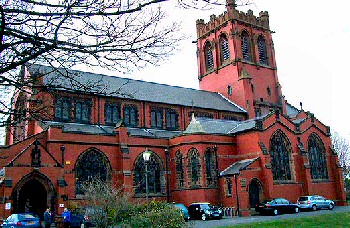|
Christmas funding boost
for Emmanuel Church, Southport
Photograph by Huw Edwards.

THE Grade II Listed
Emmanuel Church, Southport, Merseyside,
is part of the Diocese of Liverpool, and has been selected as one of a total
of 29 churches and chapels in England, Wales, Scotland and Northern Ireland
to benefit from the latest grants from the National Churches, the UK Church
epair and support charity. Located on the main road heading
north out of Southport, Emmanuel Church is still the largest building in the
area, seating 1,300. It's hoped that by sharing part of the £390,000 funding
payout from the National Churches Trust, this much loved, red brick Church
will remain a major landmark for years to come.
The latest grant announcement concludes a year (2015) in which the UK's
Church repair and support charity has awarded or recommended funding of £2.2
million to help 177 Churches, Chapels and meeting houses.
Top of the 2015 list of funding requests received by the charity include
repairs to roofs, stonework and drainage and the provision of toilets,
kitchens and disabled access and Emmanuel Church is no exemption to this.
Broadcaster and journalist Huw Edwards, Vice-President of the National
Churches
Trust said:- "I'm delighted that
this Christmas the future of Emmanuel Church, Southport is being safeguarded
by a National Churches Trust grant. This funding will help ensure that this
vitally important church continues to serve local people for many years to
come. At the heart of the nation's history and at the centre of local
communities, churches and chapels are some of the UK's best loved local
buildings. But their future is not guaranteed. So this Christmas, when
people visit a church for a carol service or even just walk past a church on
the way to do the Christmas shopping, I urge them to think about how they
can help ensure that churches remain open and good repair for future
generations. Everyone can make a contribution to the future of the UK's
church and chapel buildings. That could be by helping to clear drains and
gutters to help keeping churches watertight, volunteering to help out as a
guide to show people the history and architecture of places of worship or
keeping an eye out for vandals or thieves. Churches and chapels may be
historic buildings, but they can be part of our future, too."
The £10,000 National Churches Trust Repair Grant has been give to help fund
major roof repairs including re-slating all of the lower level roofs on the
North side, including the chancel using re-claimed slates. Damaged timbers
will be repaired/replaced and treated against further decay, within Emmanuel
Church structure.
With a watertight building, the Church then plans to increase the numbers of
activities, especially concerts and exhibitions and school visits.
"Increased use of the building will allow the wider community to engage with
the Church's history and architecture." said a representative from
the Church.
Did you know?
The foundation stone, of Emmanuel Church, was laid in 1895, by the widow of
Rev. Charles Hesketh who donated the site. The Church was then built to the
design of architects Preston and Vaughan. Emmanuel Church was constructed
using Ruabon Brick, along with sandstone dressings and a complex slated
roof.
Emmanuel Church is built in the Gothic style with great attention to detail
for such a large building, there are several well preserved gargoyles and
these features repay careful examination. The most immediately obvious
architectural features, however, are the impressive Crossing Tower and the
unusual double gabled South Transept.
Many stained glass windows were added between 1898 (the East Window) and
1935. Most of these were given as memorials and are largely typical of their
period. The 7 light, West Window (1899) is particularly good; this was
restored in 2006.
The Tower, a 1901 addition, contains a ring of 8 bells, weighing 630kg, made
by Taylors of Loughborough. With the exception of wartime, these bells have
been rung regularly since their installation.
The organ (1914) is by renowned builder, Harrisons of Durham and retains its
original specification albeit with electric action since its restoration in
2000.
The Church, being the largest in the area, is used for a wide range of
larger public gatherings, in addition to worship such as:- concerts and
exhibitions, local school events like concerts, educational visits and many
other things.
|
